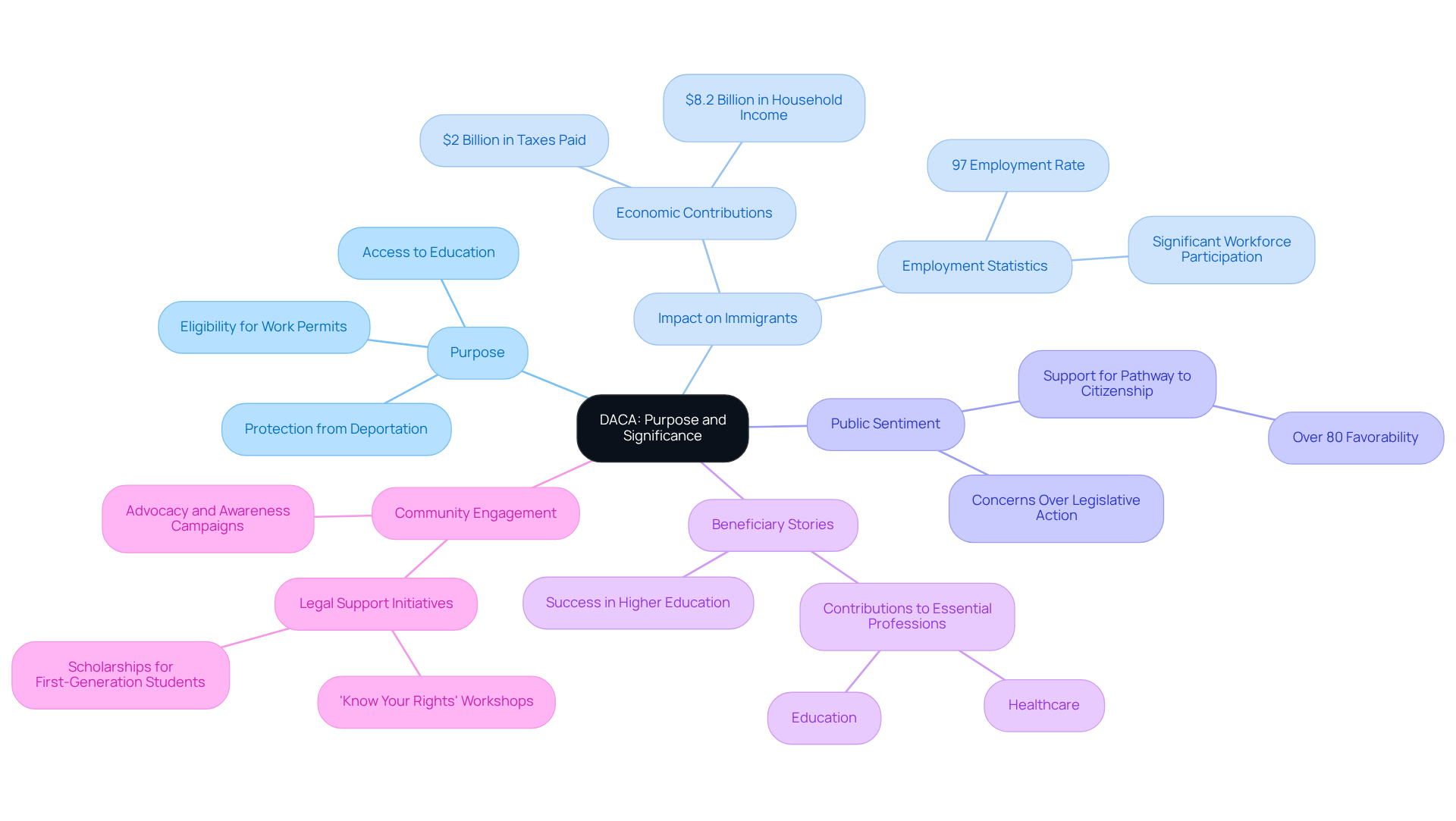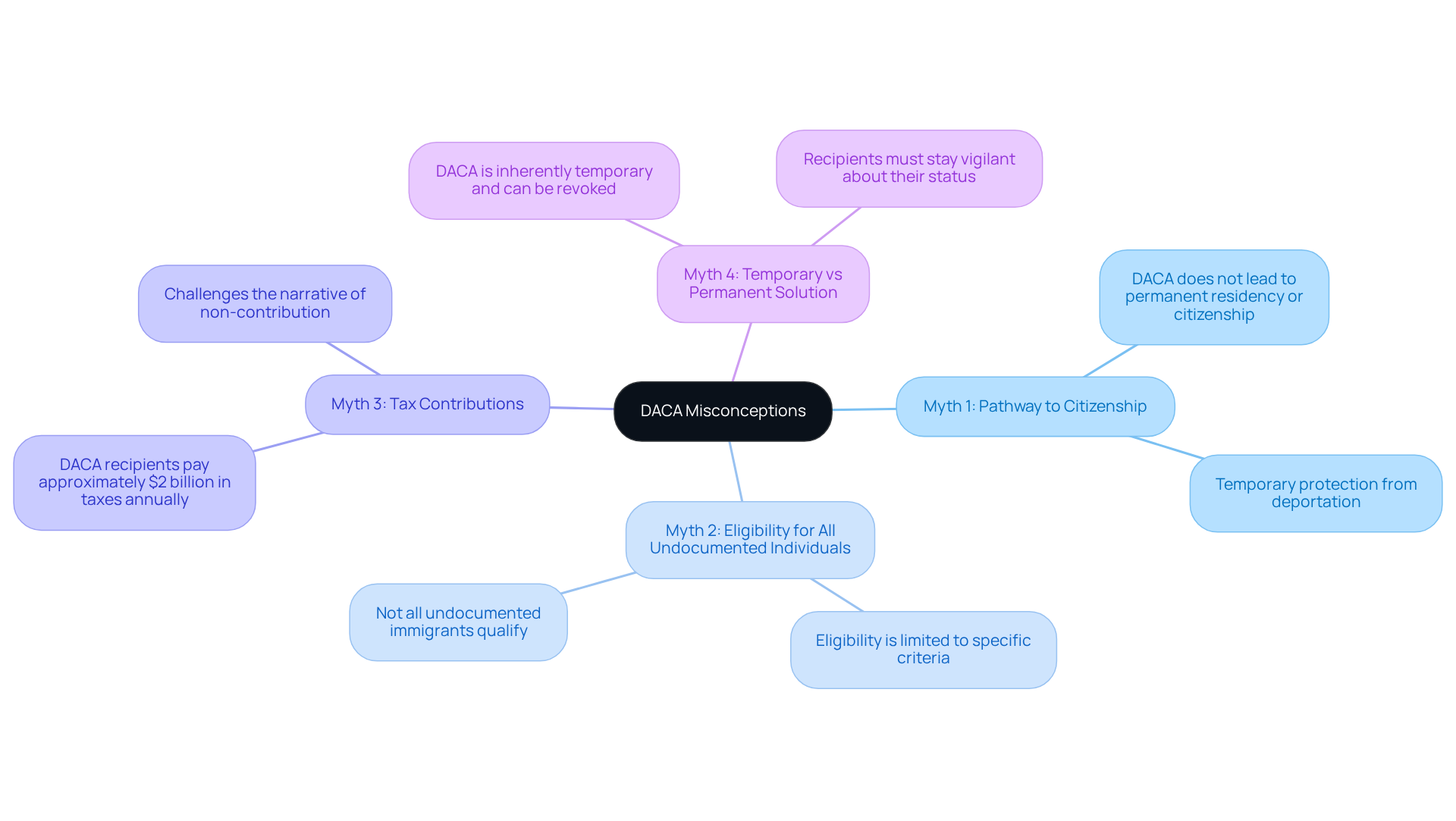Overview
DACA eligibility hinges on specific criteria: age, continuous residence in the U.S., and educational or military service requirements. It’s crucial to meet these standards to qualify for the program.
Have you ever felt overwhelmed by the complexities of immigration processes? You’re not alone. Misunderstandings about DACA’s purpose and limitations can create confusion, especially regarding its temporary nature and the absence of a pathway to citizenship.
Understanding these criteria is essential for potential applicants. We know how daunting this can feel, but clarity is key. You deserve to know your rights and options.
Remember, we’re in this fight with you, ready to guide you through every step. Your future matters to us, and we’re here to help you navigate this challenging landscape.
Introduction
Understanding the complexities of Deferred Action for Childhood Arrivals (DACA) is crucial for many young immigrants navigating U.S. immigration policy. This program offers not just temporary relief from deportation but also opens doors to educational and job opportunities that can change lives. Yet, misconceptions about DACA eligibility and its implications are widespread, leading to confusion and uncertainty for potential applicants.
- Have you ever felt lost in the immigration process?
- What are the key criteria for DACA, and how can you ensure you meet them while avoiding common pitfalls?
- It’s important to know you have rights, even if others tell you otherwise.
- We’re here to fight for your family and help you understand your options.
Define DACA: Purpose and Significance
Deferred Action for Childhood Arrivals (DACA) is a vital U.S. immigration policy established in 2012. It offers undocumented individuals who entered the country as children a renewable two-year reprieve from deportation. This policy is essential because it allows individuals to meet DACA eligibility, enabling them to apply for work permits and contribute meaningfully to society without the constant fear of deportation. Designed to protect young people brought to the U.S. through no fault of their own, DACA helps them pursue educational and job opportunities while living legally in the country, albeit temporarily.
The impact of DACA on undocumented immigrants is profound. For instance, nearly 90,000 Texans currently benefit from the program, with 97% actively working and significantly contributing to the workforce. Dreamers collectively contribute around $2 billion in state, local, and federal taxes each year in Texas alone, underscoring their crucial role in the economy. Public sentiment largely supports DACA, with over 80% of Americans favoring a pathway to citizenship for Dreamers, reflecting a recognition of their contributions and the need for stability in their lives.
Real-life stories of DACA beneficiaries highlight the program's importance. Many have successfully pursued higher education and entered essential professions, such as healthcare and education, enriching their communities. As Tricia McLaughlin, a DHS official, stated, "These are people who have built their lives here... we’re losing longstanding community members who are contributing to the country."
At Vasquez Law Firm, we understand the unique challenges faced by the Hispanic community, especially when navigating immigration policies like DACA. With over 30 years of experience and a 97% success rate, our bilingual team is committed to providing expert representation for immigration and personal injury matters. We engage with our community through initiatives like 'Know Your Rights' workshops, which inform individuals about their rights, and annual scholarships for first-generation college students pursuing careers in law. These efforts reflect our dedication to empowering our community through clear communication, cultural respect, and accessible services, including free consultations and flexible payment options.
As we look to 2025, ongoing legal challenges surrounding DACA create uncertainty for recipients, yet DACA eligibility continues to be a beacon of hope for many young immigrants striving for a better future. The potential loss of immigration protections could lead to significant economic and social consequences, highlighting the need for continued advocacy and support for these individuals who have become vital members of society.
We’re here to fight for your family. Your future matters to us. Yo Peleo — We Fight.

Outline DACA Eligibility Criteria
To qualify for DACA, applicants need to meet these key criteria:
- Age Requirement: You must have been under 31 as of June 15, 2012, meaning you were born on or after June 16, 1981.
- Arrival in the U.S.: You must have entered the United States before turning 16.
- Continuous Residence: You must have continuously lived in the U.S. since June 15, 2007.
- Education or Military Service: You should be currently enrolled in school, have graduated from high school, obtained a GED, or been honorably discharged from the military.
- Criminal Background: You must not have been convicted of a felony, significant misdemeanor, or multiple misdemeanors, and you should not pose a threat to national security or public safety.
Understanding these criteria is crucial as they form the foundation for your eligibility and the application process. If you face any legal emergencies, like receiving a subpoena or encountering ICE enforcement actions, it’s vital to know your rights. You have the right to remain silent and the right to an attorney. If you find yourself in such a situation, reach out to Vasquez Law Firm right away for urgent support. We offer tailored representation in immigration, personal injury, and family law, ensuring you get the care and guidance you need. Here’s how to get started with your free consultation:
- Schedule your free consultation
- Meet with our attorneys
- Discuss the details of your case
- Receive personalized legal advice
- Learn about your legal options
Don’t wait—your rights and freedom may depend on taking action now.
Address Common Challenges and Misconceptions About DACA
Many misconceptions about DACA can create confusion for potential applicants and the public alike.
-
Myth 1: DACA provides a pathway to citizenship. Contrary to popular belief, this program doesn’t lead to permanent residency or citizenship. It offers only temporary protection from deportation and work authorization. Think of it as a stopgap measure, not a permanent solution.
-
Myth 2: All undocumented individuals can apply for deferred action. DACA eligibility is limited to those who meet specific criteria, including age and residency requirements. Not every undocumented immigrant qualifies for the program.
-
Myth 3: Recipients of the program do not pay taxes. In reality, DACA recipients contribute significantly to the economy, paying around $2 billion in state and local taxes each year. This challenges the narrative that undocumented immigrants don’t contribute to society.
-
Myth 4: The program is a permanent solution. DACA is inherently temporary and can be revoked or altered by the government. Recipients need to stay vigilant about their status, as changes in policy could impact their protections.
Understanding these misconceptions is crucial for anyone considering DACA. It helps you navigate your options effectively and avoid potential pitfalls. If you receive a subpoena or encounter immigration enforcement, including ICE actions or deportation processes, it’s vital to know your rights: you can remain silent, have an attorney, and choose not to sign documents without professional advice. Immediate action is essential—exercise your right to remain silent and reach out to Vasquez Law Firm for urgent legal assistance. Remember, while DACA provides essential protections, it doesn’t offer a definitive path to citizenship or permanent residency.

Conclusion
DACA, or Deferred Action for Childhood Arrivals, is more than just an immigration policy; it’s a lifeline for undocumented individuals who came to the U.S. as children. This program offers a temporary reprieve from deportation, allowing eligible individuals to work legally and integrate into society. For many young immigrants, DACA symbolizes hope and stability as they strive for a better future.
Understanding DACA eligibility is crucial. Applicants must meet specific criteria, including:
- Age
- Continuous residency
- Educational or military service requirements
There are common misconceptions, like the idea that DACA provides a pathway to citizenship or that all undocumented individuals can apply. It’s essential to clarify these points, as they help potential applicants and advocates navigate the complexities of immigration law and highlight the valuable contributions of DACA recipients to our economy and society.
As the future of DACA faces uncertainty amid ongoing legal challenges, staying informed and engaged is vital. Advocacy for DACA and support for its beneficiaries are crucial in recognizing their contributions and ensuring their rights are protected. By understanding the realities of DACA and dispelling myths, we can create a more inclusive environment that values the potential of all individuals—especially those who have built their lives in the U.S. with the hope of a brighter tomorrow.
We’re here to fight for your family. Your future matters to us. Yo Peleo — We Fight.
Frequently Asked Questions
What is DACA and when was it established?
DACA, or Deferred Action for Childhood Arrivals, is a U.S. immigration policy established in 2012. It provides undocumented individuals who entered the country as children a renewable two-year reprieve from deportation.
Who is eligible for DACA?
DACA eligibility is designed for undocumented individuals who were brought to the U.S. as children and allows them to apply for work permits and live legally in the country temporarily.
What impact does DACA have on undocumented immigrants?
DACA has a profound impact, allowing nearly 90,000 Texans to benefit from the program, with 97% actively working and contributing significantly to the workforce. Dreamers in Texas contribute around $2 billion in taxes each year.
How does public sentiment reflect on DACA?
Public sentiment is largely supportive of DACA, with over 80% of Americans favoring a pathway to citizenship for Dreamers, recognizing their contributions and the need for stability in their lives.
What are some success stories of DACA beneficiaries?
Many DACA beneficiaries have pursued higher education and entered essential professions, such as healthcare and education, enriching their communities and contributing to society.
What services does Vasquez Law Firm provide regarding DACA?
Vasquez Law Firm offers expert representation for immigration matters, engaging with the community through initiatives like 'Know Your Rights' workshops and providing scholarships for first-generation college students. They also offer free consultations and flexible payment options.
What challenges does DACA face moving forward?
Ongoing legal challenges surrounding DACA create uncertainty for recipients, but the program continues to be a source of hope for many young immigrants striving for a better future.
Why is DACA considered significant for society?
DACA is significant because it allows young immigrants to pursue educational and job opportunities legally, contributing to the economy and community, while also highlighting the need for continued advocacy and support for these individuals.




